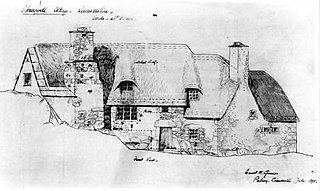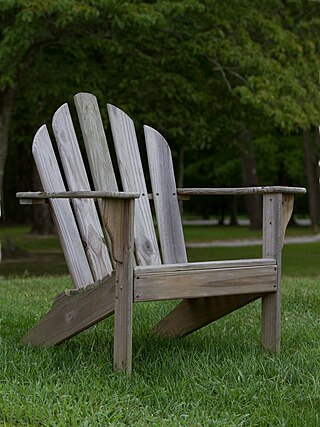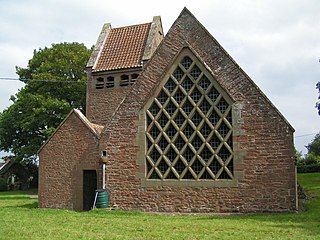
Woodworking is the skill of making items from wood, and includes cabinetry, furniture making, wood carving, joinery, carpentry, and woodturning.

The router is a power tool with a flat base and a rotating blade extending past the base. The spindle may be driven by an electric motor or by a pneumatic motor. It routs an area in hard material, such as wood or plastic. Routers are used most often in woodworking, especially cabinetry. They may be handheld or affixed to router tables. Some woodworkers consider the router one of the most versatile power tools.

A Windsor chair is a chair built with a solid wooden seat into which the chair-back and legs are round-tenoned, or pushed into drilled holes, in contrast to other styles of chairs whose back legs and back uprights are continuous. The seats of Windsor chairs are often carved into a shallow dish or saddle shape for comfort. Traditionally, the legs, stretchers, and uprights were usually turned on a pole lathe. Spindles may also be carved, using drawknives and spokeshaves. The back and sometimes the arm pieces are formed from steam bent pieces of wood. Traditional Windsors are typically painted, primarily to hide the different types of wood used in construction, based on their characteristics.

William Richard Lethaby was an English architect and architectural historian whose ideas were highly influential on the late Arts and Crafts and early Modern movements in architecture, and in the fields of conservation and art education.

Ernest William Gimson was an English furniture designer and architect. Gimson was described by the art critic Nikolaus Pevsner as "the greatest of the English architect-designers". Today his reputation is securely established as one of the most influential designers of the English Arts and Crafts movement in the late nineteenth and early twentieth centuries.

Norman Jewson was an English architect-craftsman of the Arts and Crafts movement, who practised in the Cotswolds. He was a distinguished, younger member of the group which had settled in Sapperton, Gloucestershire, a village in rural southwest England, under the influence of Ernest Gimson. Surviving into old age, he brought their ideas and working methods into the second half of the twentieth century. His book of reminiscences has become established as a minor classic of the English Arts and Crafts movement. His repair of the Tudor Owlpen Manor in 1925–26 is often regarded as his most representative and successful work.
This glossary of woodworking lists a number of specialized terms and concepts used in woodworking, carpentry, and related disciplines.
Detmar Jellings Blow was a British architect of the early 20th century, who designed principally in the arts and crafts style. His clients belonged chiefly to the British aristocracy, and later he became estates manager to the Duke of Westminster.

Sapperton is a village and civil parish in the Cotswold District of Gloucestershire in England, about 4.5 miles (7.2 km) west of Cirencester. It is most famous for Sapperton Canal Tunnel, and its connection with the Cotswold Arts and Crafts Movement in the early 20th century. It had a population of 424, which had reduced to 412 at the 2011 census.
Alfred Hoare Powell (1865–1960) was an English Arts and Crafts architect, and designer and painter of pottery.

Blackwell is a large house in the English Lake District, designed in the Arts and Crafts style by Baillie Scott. It was built in 1898–1900, as a holiday home for Sir Edward Holt, a wealthy Manchester brewer. It is near the town of Bowness-on-Windermere with views looking over Windermere and across to the Coniston Fells.
Ernest and Sidney Howard Barnsley were Arts and Crafts movement master builders, furniture designers and makers associated with Ernest Gimson. In the early 20th century they had workshops at Sapperton, Gloucestershire.

Rustic furniture is furniture employing sticks, twigs or logs for a natural look. The term “rustic” is derived from Latin “rusticus”. The style is rooted in Romantic tradition. In the US it is almost synonymous with the National Park Service rustic style of architecture. Many companies, artists and craftspeople make rustic furniture in a variety of styles and with a variety of historical and contemporary influences.
Peter Waals, born Pieter van der Waals, was a Dutch cabinet maker associated with the Arts and Crafts movement.
Matthew Burt is a British furniture designer-maker who runs a contemporary practice from a studio and workshop based in the South Wiltshire village of Sherrington, west of Salisbury. His work has been displayed in significant public exhibitions, most notably in the OneTree touring show and at the House of Commons in 2008 in a selection of work intended to raise the profile of UK furniture making. Burt's workshop steadily built on a reputation for furniture design that allies structurally robust work that fulfils its function with a lean, elegant line and the occasional bravura surface. Burt has said that he regards the 'intermingling of science, engineering, mathematics, aesthetics and metaphorics' as the building blocks for his furniture.
Geoffrey Henry Lupton was a British architect and furniture designer who is best known for his contribution to the Arts and Crafts movement, working with Ernest Gimson and Sidney Barnsley.

The Church of St Edward the Confessor in Kempley is a Church of England parish church in the Forest of Dean district of Gloucestershire, England, close to the border with Herefordshire.

Stoneywell is a National Trust property in Ulverscroft, a dispersed settlement near Coalville in Charnwood Forest, Leicestershire. Stoneywell is the largest of a small group of cottages designed in the Arts and Crafts style by Ernest Gimson. It was built in collaboration with Detmar Blow in 1899 for Ernest's brother Sydney Gimson as a summer residence, and along with much original furniture, it remained in the Gimson family for over a century. As part of a highly influential vernacular movement, it has become well known within Arts and Crafts circles. In spring 2013 the National Trust announced that following a year-long appeal, it had been able to acquire the house with its Arts and Crafts contents, gardens and woodland. It was opened to the public in February 2015.

A cabinet is a case or cupboard with shelves and/or drawers for storing or displaying items. Some cabinets are stand alone while others are built in to a wall or are attached to it like a medicine cabinet. Cabinets are typically made of wood, coated steel, or synthetic materials. Commercial grade cabinets usually have a melamine-particleboard substrate and are covered in a high pressure decorative laminate, commonly referred to as Wilsonart or Formica.

Daneway House is a grade I listed house in the parish of Bisley-with-Lypiatt but close to Sapperton in Gloucestershire, England.














